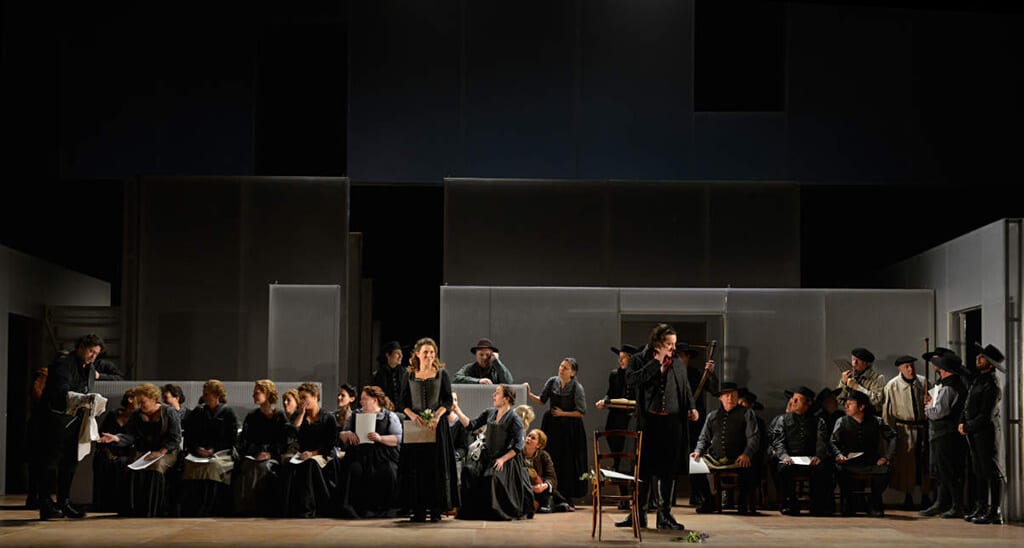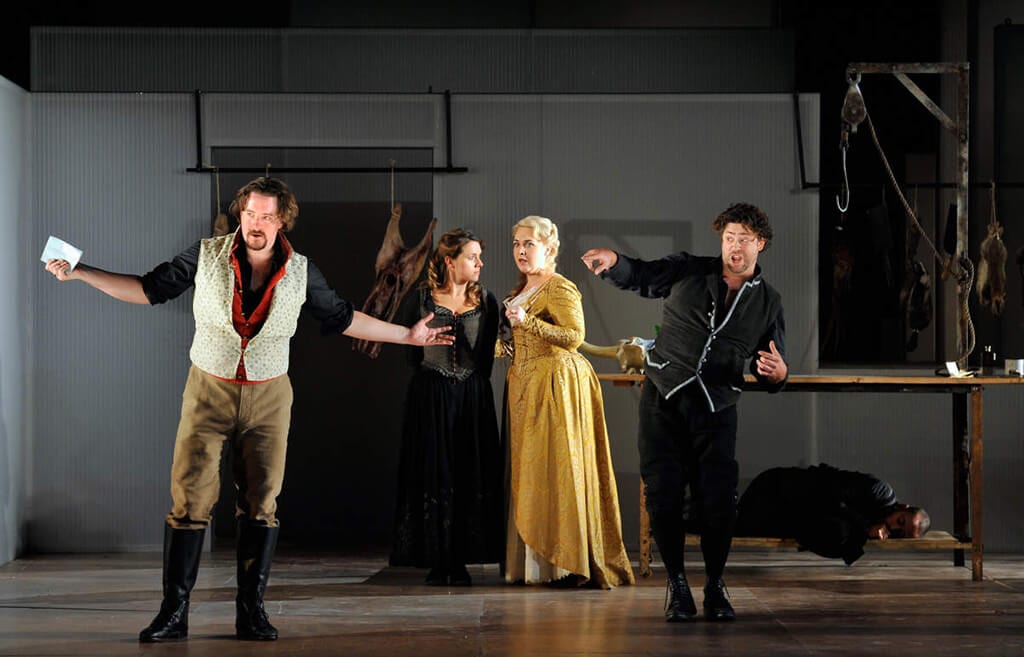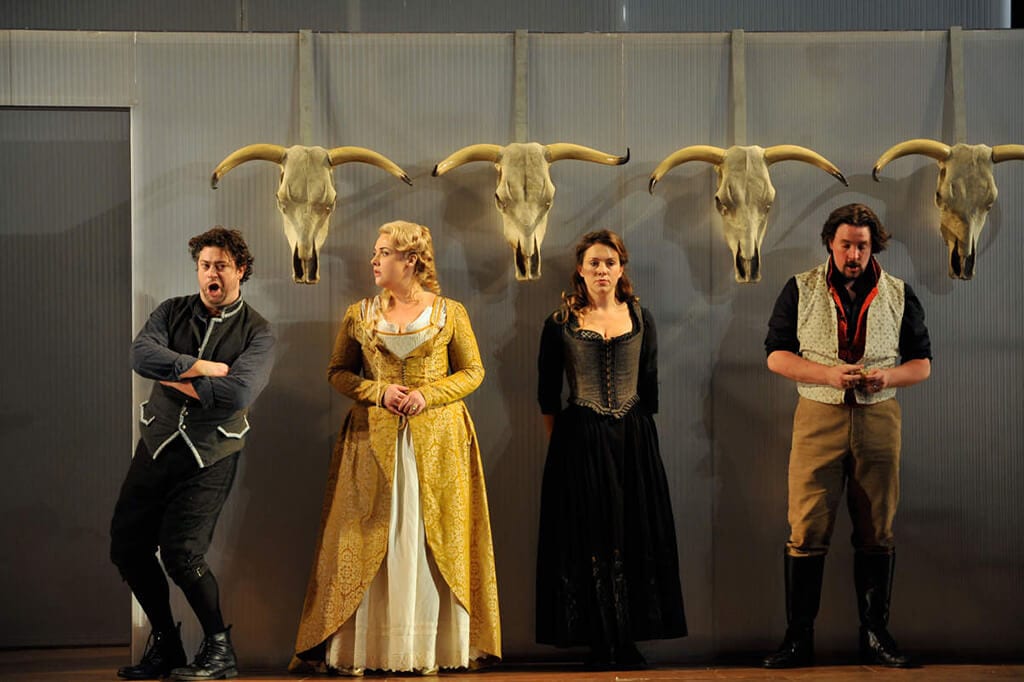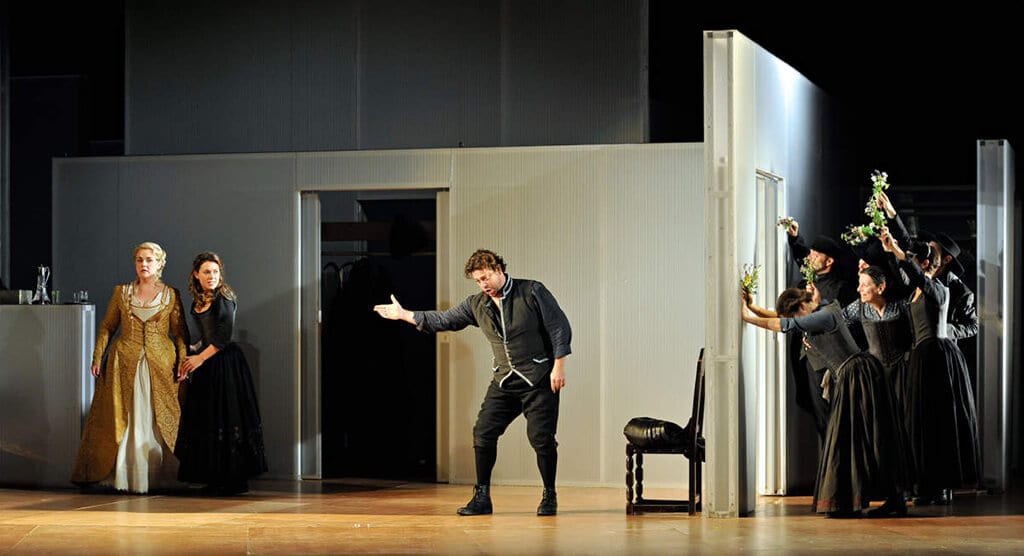It took me a while to grow comfortable with (or even figure out) the visual and metaphoric concept behind this production of The Marriage of Figaro, but by the middle of the second scene I felt I had figured it out and I began to like the idea. The crazy day in the Almaviva household is well-represented by a set that keeps revolving; keeps shifting into a series of mazes; references the maze of the Minotaur myth (Figaro as Theseus doing the bull dance or Almaviva as the cruel king?). There is also obviously good reason for a story set in 18th century Spain to be full of the imagery of dead bulls, bull masks and the bull fight. The design by Peter McKintosh is also evocative of the original era of the revolutionary, disturbing play by Beaumarchais. The comedy was paramount, just; but this was a darker and more considered production than you often get of Figaro. Like the famous production a few years ago at the Royal Opera House, the castle abounds with life, with servants and supernumeraries bustling about the maze doing their duties. There is a constant sub-text and sub-story to think about.
In the end, though, it is not the concept that drives this production. The evening works so well because the director, Fiona Shaw, knows how to get her singers not only to perform the music brilliantly but to act their characters; the cast understands and conveys the nuances and complications of the various relationships. This is a seriously intelligent Figaro interpretation and by the end, though the music is telling you that forgiveness and reconciliation can be transcendent and are possible. Though you are basking in the wonderful world of sound that is created by the score (and the increasingly fine ENO orchestra), the thrust of the story and the way the actors have shown their reactions suggests strongly that the reconciliations will be short lived and that the Count will betray his Countess again.
Therefore this is an interpretation informed by the third of the Figaro plays, The Guilty Mother (La Mère Coupable); and by the end of the first half you begin to suspect and foresee the affair that’s bound to happen sooner or later between the betrayed, restless and disappointed Countess and the young, energetic and sexually charged Cherubino. (You can also, of course, see the inspiration that this text gave to Hugo Von Hoffmansthal when he wrote Der Rosenkavalier for Richard Strauss.) This is a literate and strongly theatrical interpretation of the opera and of the play behind it; it is directed by a consummate actress who here shows herself also to be a mistress of theatre as a director.
Ultimately, though, Mozart’s sublime and humane music carries the emotions and provokes the intellectual interpretation – and Shaw knows how to listen to the music and interpret it dramatically, through the singers and their reactions to events. The constant movement of the revolving set and the extra actors moving through the mazes, the choreography of all the movement as well as of the actual dances, the life going on in the corridors or behind the scenes that we observe and that gives the sense of the very public life of the Almaviva palace: all this enhances the sense of urgency and restlessness in the tale.
The ENO has a strong cast in this first revival of Shaw’s production, with everyone working together brilliantly as an ensemble but also shining in their solo moments. The climax of the evening, as it should be, is the third scene. Each of the events in that sequence is telling, with the Countess’s solo aria and her duet with Susanna outstanding both musically and dramatically (full praises with no quibbles to Sarah-Jane Brandon as the tortured and lovely Countess and to Mary Bevan, playing Susanna after being promoted from playing Barbarina last time). The Count’s fury and psychopathy are brilliantly and frighteningly conveyed in his solo by Benedict Nelson; and the trio of David Stout’s Figaro, Lucy Schaufer’s fruity Marcellina and Jonathan Best’s crabby, tight-fisted Bartolo succeeds in provoking considerable laughter in the recognition scene where it turns out that Figaro is the long-lost illegitimate offspring of the couple that are trying to cheat him, leading so preposterously but delightfully to happy marriages all round to the great fury of the Count. One must also note the fine contribution of Samantha Price’s boyish, androgynous Cherubino throughout. As for the Barbarina of Ellie Laugherne, her voice is so lovely and her acting so natural that she is very likely to be Susanna next time round if Mary Bevan isn’t available.
Musically Jaime Martin keeps complete control of the score and offers some really illuminating musical moments. The music and drama develop just as they should, and the confused dénouement in the garden/maze works with a clarity and impact that are very satisfying. Susanna’s big, loving aria and Figaro’s jealousy in the final scene are also memorable highlights, both exquisitely controlled.
This is a fine evening of opera with all the elements blending seamlessly. The night I attended, Mary Bevan was presented with a well-deserved Critics’ Circle Award for Exceptional Young Talent during the applause at the end – having proved by her singing and acting that she is a very deserving winner.





